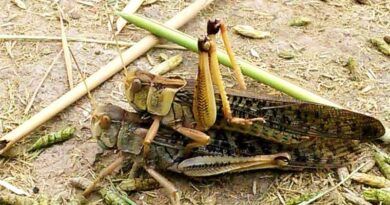Study recommends greater awareness of biopesticides to help fight locust outbreaks in China
11 April 2023, China: A new study led by scientists from the Chinese MARA-CABI Joint Laboratory for Biosafety suggests greater awareness of biopesticide market availability, efficacy and field application processes could help tackle locust outbreaks in China.
The researchers, who outline their findings in the journal Sustainability, argue that future studies should also focus on modelling the expected impact and cost effectiveness of chemicals verses biopesticides – therefore increasing the evidence base for promoting more environmentally friendly biopesticide use.
Locusts are among the world’s most destructive pests that cause significant financial loss and ecological damage in many parts of the world. In China, the scientists highlight that locust outbreaks have a 3,000-year history and – along with floods and droughts – are considered the three biggest natural disasters for the country.
They add that successes have been achieved by using emerging technologies – including spraying of the locusts using drones, GPS tracking, GIS mapping and satellite data imagery – but chemical pesticides in China and other countries remains the primary method of control for the pests.
Though, China has made great strides with the use of biopesticides, the researchers stress and further highlight that a reason why chemical pesticides are chosen is due to their fast action despite more negative impacts on the environment.
The scientists say that the uptake of biopesticides remains low due to various factors including inconsistent field results, shorter product life, high costs and effectiveness on a smaller range of pests as compared to other products. Despite this, there is increasing evidence of the benefits of biopesticides in general, including for locusts.
Dr Hongmei Li, lead author of the paper and Senior Scientist, based at CABI’s centre in China, said, “Our findings show that China has an integrated national locust response protocol, which involves various institutions from all administrative levels of government.
“The process is inherently highly complex but efficient with multi-sectoral agencies working closely together to prevent and/or manage locust outbreaks.
“In addition, the process has been successful in combating recent outbreaks, due to dedicated government funding, decisive administrative and technical actions as well as the empowerment of local government administration.”
She adds that this is particularly the case with the county level acting as a ‘first responder’ that is financially and technically able to respond to a locust invasion in their jurisdiction.
Co-author, Dr Mariam Kadzamira, Senior Researcher, Agribusiness, based at CABI’s head office in Wallingford, UK, said, “Our research also shows that despite the availability of biopesticides in local markets, their use is dampened by inadequate information about market availability, negative perceptions by decision-makers about their efficacy and concerns about their costs as well as limited knowledge of their application techniques.
“Actions are, therefore, needed by relevant authorities to enhance stakeholder awareness of biopesticide market availability, efficacy and field application processes.”
The researchers stress that to increase the use of biopesticides for locust control there should be evidence-based local exemplars and case studies, and where possible, this should include comparisons with the long-term outcomes of using biopesticides verses chemical pesticides on locust populations.
They further add that since pest outbreaks necessitate quick and decisive actions for success, information packages should be made available to decision-makers on an on-going basis – not just when there is an outbreak.
Dr Hongmei Li added, “In addition, other research should centre around metrics-based process mapping that includes analysing the time lag between strategic actions during a locust outbreak.”
Dr Kadzamira highlighted that this would “facilitate a better understanding and mapping of work flows and would contribute to improving the efficiency of different actors across all relevant administrative structures, in the event of a locust emergency.”
The scientists based their research on Yunnan Province as a case study as it was one of the worst areas affected in the 2020 locust invasion. It was also chosen as efforts to control the locusts during this invasion were relatively successful and, therefore, understanding the processes could inform future management of the pest, for China, as well as for other countries.
(For Latest Agriculture News & Updates, follow Krishak Jagat on Google News)














